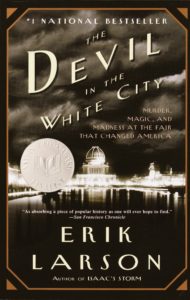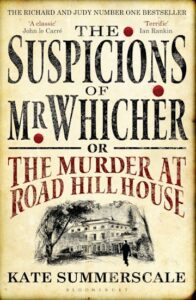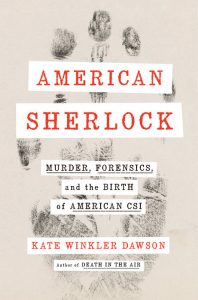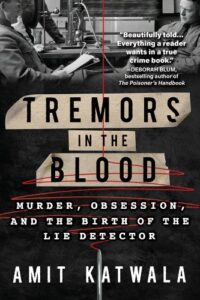History tends to focus on the upper echelons of society: aristocrats and military leaders, sweeping battles and palace intrigue. But I’d argue that to really understand a time and place there’s no better guide than true crime—murderers and miscreants can tell us more about the challenges faced by ordinary folk than any number of stuffy costume dramas.
When I was writing Tremors in the Blood: Murder, Obsession and the Birth of the Lie Detector, I tried to go a step further, and use the stories of two controversial murders to tell a much bigger one—about a machine that has transformed the justice system and become a trope in all sorts of crime stories itself.
In writing my book about the polygraph machine, I was inspired by a number of titles that blend true crime with history, mixing investigations and courtroom drama with insight on the world and how it has changed. Digging through newspaper archives and old letters and photographs to reconstruct scenes and build characters, I started to feel like a detective myself, and I was struck by the parallels between the book’s setting of 1920s San Francisco and 1930s Chicago and the challenges and talking points of the world today.
At their best, the books below tell us not only about life and crime back then, but also something enduring about human nature that’s still relevant today. This is history written not by the victors, but by the villains, and the people trying to catch them.

The Devil in the White City: Murder, Magic and Madness at the Fair that Changed America, by Erik Larson
Like many of the books on this list, Larson’s utterly absorbing book tackles two subjects, in this case the planning and construction of the era-defining 1893 Chicago World’s Fair, and a prolific serial killer called H.H. Holmes who was operating in the city at the time. Chicago was a fascinating city at the turn of the century: opulent and impoverished, grand and cruel in equal measure (for more on this read The Jungle by Upton Sinclair, a fictionalized account of the very real struggles faced by Eastern European migrants in the city.) Larson’s narrative jumps back and forth between these two streams: architects Daniel Burnham and Frederick Law Olmstead grapple with bureaucracy and labor unions as they struggle to realize their vision; Holmes perfects his technique, luring more and more young women to their doom at his so-called ‘Murder Castle’.

Furious Hours: Murder, Fraud and the Last Trial of Harper Lee, by Casey Cep
If you’ve read Truman Capote’s In Cold Blood—and if you haven’t, why not?—you’ll love this book about Harper Lee, who was Capote’s long-time friend and collaborator, as well as the famously reclusive author of To Kill A Mockingbird. Lee helped Capote with the research for his genre-defining true crime masterpiece, and then spent much of the rest of her life absorbed in a project of her own—the story of the Reverend Willie Maxwell, a preacher accused of murdering five members of his family for the insurance money, who was then shot dead himself. That book was never published, but this one provides a fascinating glimpse at what could have been.

The Suspicions of Mr. Whicher: or The Murder at Road Hill House, by Kate Summerscale
Who was the real Sherlock Holmes? You can see some of the seeds of his character in Jack Whicher, a London police officer who became famous in Victorian England for his ability to apprehend everyone from pickpockets and diamond thieves. Whicher was the shining light of Scotland Yard, then a new and modern policing operation that was changing the profession—as well as Holmes, he’s been cited as a source for Charles Dickens, and for Colin Dexter’s Inspector Morse. But Kate Summerscale’s book explores the gruesome murder of a young boy at a country house in Wiltshire that almost proved Whicher’s undoing. At the same time, it traces the history of the detective archetype in fiction, from Holmes, through Dickens to more modern coppers.

American Sherlock: Murder, Forensics and the Birth of American CSI, by Kate Winkler Dawson
The polygraph machine was developed as part of a science-driven revolution in policing overseen by August Vollmer, Berkeley’s visionary police chief in the early 20th century. In my book, I look at how Vollmer and one of his detectives built the first lie detector, but that wasn’t the only innovation. Vollmer was also instrumental in popularizing the use of forensics, which have left a much more positive legacy than the polygraph.
Winkler Dawson’s book focuses on Edward Oscar Heinrich, who opened America’s first private crime lab, and was asked to consult on thousands of cases from the 1910s to the 1950s: he pioneered fingerprinting, the use of ballistics to track bullets, as well as more dubious techniques like handwriting analysis. All in all, he worked on more than 2000 cases and changed the way we catch criminals forever.

Killers of the Flower Moon: The Osage Murders and the Birth of the FBI, by David Grann
Soon to be a Martin Scorsese blockbuster, Killers of the Flower Moon explores a series of suspicious deaths among the Osage people of Oklahoma, who were famous in the 1920s for the fabulous wealth they amassed after huge oil deposits were discovered on their land. Their story had been all but forgotten until Grann’s book, which opens with the murder of Osage woman Anna Brown, and tracks the investigation into the deaths by the newly formed FBI, as iconic special agent Tom White unravels the secret plot behind the killings.
***
Tremors in the Blood: Murder, Obsession and the Birth of the Lie Detector by Amit Katwala was published on March 7 (Crooked Lane Books)





















